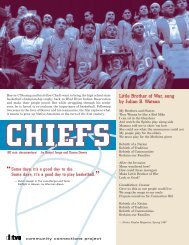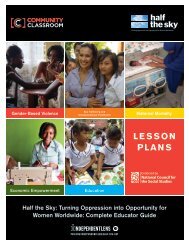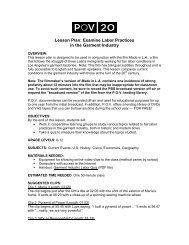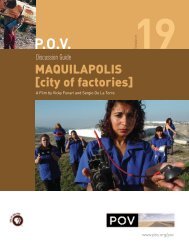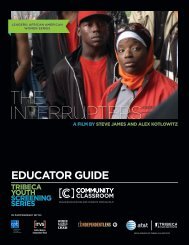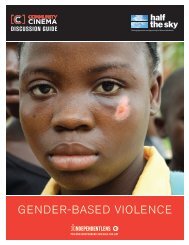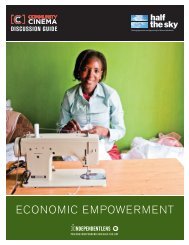Download lesson plan (PDF) - FutureStates
Download lesson plan (PDF) - FutureStates
Download lesson plan (PDF) - FutureStates
Create successful ePaper yourself
Turn your PDF publications into a flip-book with our unique Google optimized e-Paper software.
PLAYLESSON PLANPRESENTED BY:ENGAGING STUDENTS AND EDUCATORS THROUGH FILMFUTURESTATES.TV
COMMUNITY CLASSROOM: PLAYCOMMUNITY CLASSROOMIndependent Television Service (ITVS)651 Brannan Street, Suite 410San Francisco, CA 94107E-mail: outreach@itvs.orghttp://www.itvs.org/classroomCOMMUNITY CLASSROOM is an innovative education resource providing short documentary videocontent and accompanying curricular materials, <strong>lesson</strong> <strong>plan</strong>s, and homework assignments to high school andcommunity college instructors and youth-serving community-based organizations. Film modules are drawnfrom documentaries scheduled for broadcast on the Emmy Award-winning PBS series Independent Lens.Content is grouped into subject specific segments that correspond to <strong>lesson</strong> <strong>plan</strong>s and educational activities.All COMMUNITY CLASSROOM <strong>lesson</strong> <strong>plan</strong>s are designed with key education standards in mind, and areavailable free of charge online, along with the film modules.COMMUNITY CLASSROOM is a program of the Independent Television Service, created with support fromthe Corporation for Public Broadcasting. Lesson <strong>plan</strong>s were developed with guidance from the AmericanAssociation of Community Colleges, KQED Education Network, National Association for Media LiteracyEducation, National Council for the Social Studies, National State Teachers of the Year, and PBS Teachers.© Copyright 2010Independent Television Service (ITVS)
COMMUNITY CLASSROOM: PLAYVIDEO GAMES AND SOCIAL CONTROLLesson Plan OverviewIn the final scene of Play, a video gamer is told, “Congratulations. Next level.” It is clear to the audience thatshe should stop playing, but she continues, unwilling or unable to exit the game.In this scene and throughout the film, Play explores a question that runs throughout science fiction writing:what happens when people lose control over the technology they developed? Writers have addressed thisquestion often in novels and films such as Frankenstein, Brave New World, Player Piano, 2001: A SpaceOdyssey, Blade Runner, and many others. Along with Play, other films in the FUTURESTATES series alsoaddress this issue. Play takes the question to the next level and cautions viewers about dependency thatcan, at times, seem to border on addiction.In this <strong>lesson</strong>, students will discuss the theme of the film Play. They will gather data about their own useof technology, discuss it, and draw conclusions. Do they agree with the writers of technological cautionarytales, or do they dismiss the fears as groundless? Students will create and present a digital response.Target AudienceThis <strong>lesson</strong> is designed for high school students of all ability levels.Total DurationThis unit will take 3-4 days, depending on the class.Educational StandardsThese Common Core Standards are addressed in this <strong>lesson</strong>:For grades 9-12: Conduct short as well as more sustained research projects to answer a question (includinga self-generated question) or solve a problem; narrow or broaden the inquiry when appropriate; synthesizemultiple sources on the subject, demonstrating understanding of the subject under investigation.FUTURESTATES.TV PAGE 1
COMMUNITY CLASSROOM: PLAYProcedures (Day 2)Teacher PreparationDetermine in advance how best to compile the data your students will bring to class today. The goal is toproduce and share two graphs: one for the number of texts the students sent and received during the pastday, and one for the amount of time they spent using technology to accomplish other tasks. The ideal optionis to select a student who can compile the information using a spreadsheet and then generate and projectthe graphs.If you have more than one class working on this <strong>lesson</strong>, it might be an interesting exercise to keep one set ofdata for each class and a second set that combines all the classes.Objective for the LessonStudents will analyze data and draw conclusions about their own interaction with technology.Lesson StructureBeginning (5-10 minutes)Divide students into small groups to compile subtotals of their data. When they have handed in group totalsto a central person who will compile the spreadsheet, they should discuss their observations about their useof technology. They can use the questions at the bottom of the data handout as a springboard for discussion.Middle (60-75 minutes)When all the data has been compiled, project a graph and discuss the following questions with the class:• What digital activity takes up the most time?• Do any of the blocks of time seem excessive?• Do the numbers of texts sent or received seem excessive?• If your parents saw this graph, how might they respond?• Think for a moment about the theme of Play. If the filmmaker saw your graph, how might herespond? Would you agree with him? Why or why not?• If young children spent as much time engaged with technology as the characters in the film, would itbe healthy or unhealthy? Explain.EndWhat conclusions can the class draw about their own use of technology? Is the amount of time involvedhealthy or unhealthy? Do they anticipate that their interactions with technology will increase or decrease asthey enter the work world?Close by connecting today’s discussion with the theme of Play. The film suggests that people may becometoo dependent on interacting with technology. Based on their own research, are students more in agreementor more in disagreement with that idea?FUTURESTATES.TV PAGE 3
COMMUNITY CLASSROOM: PLAYProcedures (Day 3)Teacher Preparation1. Determine in advance what online tools will best enable your students to produce a digital response to their research.This response might take the form of a cautionary tale for today, a warning for young children, or a report on “internetaddiction” or the overuse of technology.• If your students are to produce a narrative, visit the Animoto.com site and become familiar with how it works beforeexpecting students to use it in the final project. If Animoto is not available at your school, consider Stupeflix.com orCapzles.com as alternatives. A narrative of sorts can be cobbled together using PowerPoint, if necessary.• Glogster.com will enable students to produce online posters with a punch.• For a more extensive project, students might wish to share information via a wiki. Wikispaces.com andWetPaint.com might prove useful. If students prefer to generate a website, Weebly.com might be a good choice.Regardless of the tool students will use, the teacher will want to visit the site and try it first.2. Determine in advance what rubric you will use to assess student work. These two sites may prove useful:• Evaluating Multimedia Presentations(http://www.learnnc.org/lp/pages/647)• Kathy Schrock’s Guide: Multimedia Rubrics(http://school.discoveryeducation.com/schrockguide/assess.html#multimedia)Distribute a copy of the rubric to students in advance.3. Schedule time in the computer lab.Objective for the LessonStudents will synthesize the theme from Play with the results of their research, analysis, and discussion to create anarrative response. This response might take the form of a cautionary tale for today; a warning for young children; orinformation about “internet addiction,” the overuse of technology, or some other topic that emerged during discussion.Lesson StructureBeginning, Middle, and End (1-2 days)Students will probably need a full class period to produce a narrative, poster, or website that demonstrates a themerelated to the wise use of technology. After production work is complete, encourage students to share their projects andto discuss why they selected certain images or information to convey a theme. Does the class feel that the images and/orinformation convey the theme well? How might the project have been improved?Extension/Supplemental ActivitiesThe Viewing Guide is intended to help students look for patterns in the film that can help them understand a theme.The Alternate Viewing Guide can serve as scaffolding for students who have difficulty following the events in the film. Itfocuses on character rather than plot or theme, so it may help students make sense of what they’re watching.Some students have difficulty interpreting images. The Analyze a Photograph activity can help develop that skill.FUTURESTATES.TV PAGE 4
COMMUNITY CLASSROOM: PLAYPlay: Interaction withTechnologyThis task is not intended to invade your privacy. All data will be compiled into a master file, and we willanalyze the results of the master file as a class. Please DO NOT put your name on this paper.Task: For the next 24 hours, keep track of how much time you spend interacting with technology. This couldinclude some or all the following:A. time spent at Facebook or other social networking sitesB. time spent following a sports team or fantasy teamC. time spent watching movies or TV shows onlineD. time spent creating, uploading, and/or watching YouTube filmsE. time spent in video games, from online games to cell phone gamesF. how many text messages you send/receiveG. any other interaction with technologyTASKTIME SPENTABCDEF SENT: RECEIVED:GReflect on the time you spend interacting with technology. Consider these questions along with otherobservations:1. Was your interaction with technology for this 24-hour period more than usual, less than usual, orabout typical for you?2. Do you ever feel that your time texting or online interferes with friendships or other relationships(siblings, parents, grandparents)?3. Do you think you use technology more than others, less than others, or about the same as others?(You will know for sure when the class compiles the data.)4. If you lost your cell phone or Web access for 24 hours, in what ways would your life be different?5. Were you surprised at the number of text messages you sent/received? Was it an acceptableamount or an excessive amount?FUTURESTATES.TV PAGE 5
COMMUNITY CLASSROOM: PLAYViewing Guide1. The film uses repetition (motifs) for emphasis. What do the following elements add to ourunderstanding or interpretation of the film?• Scenes in which someone is drinking.• Scenes in which someone looks at their hands.• Scenes in which gamers wear something on their heads.• Scenes in which the Mystery Child appears.2. What theme(s) do you find in this film? What details support your interpretation?FUTURESTATES.TV PAGE 6
COMMUNITY CLASSROOM: PLAYViewing Guide (Teachers Edition)1. The film uses repetition (motifs) for emphasis. What do the following elements add to ourunderstanding or interpretation of the film?• Scenes in which someone is drinking.In the opening scene, the thug drinks while walking down the street and thenbecomes violent. Akira, the Japanese student, drinks during the pillow fight andregains energy to continue. (We see a change in her health bar/life bar.) The waiterbrings water to Barry and Jenni/Jessie/Jasmine, but no one drinks and the gamegoes nowhere. The Mystery Child brings water to the girl in the woods. After shedrinks, she moves to the next level. In each case, drinking is equated with gainingenergy.• Scenes in which someone looks at their hands.Sakurako looks at her hands after taking off her headgear. The Senator looks at hishands before getting out of the car, and the young woman in the woods looks at herhands after stepping out of the door. Looking at hands suggests that the person istrying to understand what persona s/he is inhabiting at that moment. The personappears to be aware that s/he is gaming.• Scenes in which gamers wear something on their heads.Sakurako wears headgear that looks like a helmet from a bad science fictionmovie. The senator’s headgear looks like a bobble-head doll. The headsets for bothDoris and the psychiatrist also look ridiculous. However, in the forest scene, theidentical forehead dots suggest that we can’t just dismiss the games as silly. Wheneveryone is doing the same thing, there must be a reason. People’s willingness tochoose the game over a beautiful natural environment and the company of otherpeople suggests that something more insidious is present. The film remains vague,however, on what that might be. The audience must decide.• Scenes in which the Mystery Child appears.The Mystery Child’s cowboy outfit suggests children’s games of the past, gamesthat required other people to be present physically and required a certain amount ofimagination from all participants. Childhood is usually seen as a time of innocence,but this child does not fit that pattern. Because he encourages people to keepplaying – even when it’s bad for them – he can be seen as a Trickster figure, one whomisleads people. The Mystery Child suggests that there is more danger than value invideo games.FUTURESTATES.TV PAGE 7
COMMUNITY CLASSROOM: PLAYViewing Guide (Teachers Edition cont.)2. What theme(s) do you find in this film? What details support your interpretation?Answers will vary. Possibilities include the following:• Overdependence on technology• Fantasy vs. reality• Quest for identityWhat matters most is the student’s support for his/her choices.Some may see Play as a cautionary tale about the dangers of spending too muchtime playing video games. Others may broaden their criticism to include alltechnology. Some students may see video games as a metaphor for relationships,pointing to the “drama” of some high school incidents as a kind of gameand pointing to some people as “drama queens.” Encourage any reasonableinterpretation that includes accurate details from the film as support.The description states, “Play has the structure of a puzzle, and is not meant toresolve into a single ex<strong>plan</strong>ation or interpretation. Rather, the film is a meditation onour present day of hyperconnectivity and information overload, using video gamesas the metaphor for the very human search for meaning and identity.”FUTURESTATES.TV PAGE 8
COMMUNITY CLASSROOM: PLAYAlternate Viewing GuideThis film does not use a traditional plot to tell a story. Instead it uses a sequence images that develops contrastsbetween different characters and actions. The film challenges the viewer to identify not WHAT is happening,but WHY. The film focuses on theme.You will notice that characters usually appear in two roles. In one scene a character will appear to be a personin real life – or what appears to be real life – while in another scene the character appears to be partof a video game. What might these contrasts suggest about the role of fantasy and reality in our everydaylives?Jot down details about the characters from the film. When you have finished, share your observations with apartner. The first character has been done for you.CharacterDorisDual RolesShe first appears as an older woman who fights off a thug who is stealing herpurse; then she turns out to be a character in a video game. Later she is thereceptionist for the psychiatrist. She is also a gamer.Sakurako (first Japanese schoolgirl)BarryJenniSenator Solomon NashPatientPsychiatristYoung woman in woodsMystery Child (cowboy outfit)FUTURESTATES.TV PAGE 9
COMMUNITY CLASSROOM: PLAYAlternate Viewing Guide(Teachers Edition)This film does not use a traditional plot to tell a story. Instead it uses a sequence images that develops contrastsbetween different characters and actions. The film challenges the viewer to identify not WHAT is happening,but WHY. The film focuses on theme.You will notice that characters usually appear in two roles. In one scene a character will appear to be a personin real life – or what appears to be real life – while in another scene the character appears to be partof a video game. What might these contrasts suggest about the role of fantasy and reality in our everydaylives?Jot down details about the characters from the film. When you have finished, share your observations with apartner. The first character has been done for you.CharacterDorisSakurako (first Japanese schoolgirl)BarryJenniSenator Solomon NashPatientPsychiatristYoung woman in woodsDual RolesShe first appears as an older woman who fights off a thug who is stealing herpurse; then she turns out to be a character in a video game. Later she is thereceptionist for the psychiatrist. She is also a gamer.At first she plays the role of a thug in a video game. Then she seems to bejust a typical schoolgirl. Then we understand that she is a character in a videogame that Barry plays.At first he seems to be a guy playing the Pillow Fight game. Next he seems tobe a guy on a blind date, until we realize he is playing a Blind Date game. Thenwe understand him to be a character in the Senator’s Blind Date game.Jenni at first seems to be a real person. Then we understand her to be a characterin the Blind Date game. In the woods she appears to be a real personwho is playing a video game and crying.At first the Senator appears to be a real person. When menus appear, however,he appears to be a character in a video game. Something goes wrong, however,and his game crashes. The audience sees him again later as one of thegamers in the woods.The patient appears to be real. She leaves the audience wondering whether allof the previous characters have been her, dreaming or playing a video game.The actions of the psychiatrist, however, leave the audience wondering whetherthe patient is real. He uses menus to respond; he is unable to leave his officeafter she does. If he is part of a game, perhaps she is, too.The psychiatrist uses menus to respond to his patient and is unable to leave hisoffice after she does. This leads the audience to suspect that he is a characterin a game. However, his actions in accepting the new game from the MysteryChild, canceling his appointments, and putting on a Game Helmet suggestthat he is real. The audience sees him again later as one of the gamers in thewoods.The young woman in the woods steps through a door that isn’t attached toanything, suggesting that she is not real, but she also looks at her hands, suggestingthat she is trying to find out who she is. She can see the seated gamers,but she can also see herself as a gamer, and the gamer can see her. Hertear suggests pity or compassion. The standing girl disappears as the MysteryChild brings water to the sitting girl and congratulates her on reaching the nextlevel, suggesting that the sitting girl is real. She is at least aware of what she isdoing.FUTURESTATES.TV PAGE 10
COMMUNITY CLASSROOM: PLAYAlternate Viewing Guide(Teachers Edition cont.)CharacterMystery Child (cowboy outfit)Dual RolesThe Mystery Child appears as both an onlooker and an active participant inthe game. He seems out of place alone at night on a city street and in the restaurantbooth, drinking cappuccino. He encourages people to keep playing bygiving Barry a clue, by giving the psychiatrist a new game, and by encouragingthe girl in the woods to level up. Significantly, he is not wearing a gamer’s dotin the final scene.FUTURESTATES.TV PAGE 11
COMMUNITY CLASSROOM: PLAYAnalyze a PhotographBeginning (20-30 minutes)Share with students a Pulitzer Prize-winning photograph, available here:http://www.pulitzer.org/works/2010-Breaking-News-PhotographyIf possible, project the photograph to the front of the room. Otherwise, it may be necessary to photocopy itand distribute copies to students. (Photocopying for classroom use does not violate copyright.)Ask students (as a class) to analyze elements of the photograph to reveal as much as possible about it. Usethe questions below to lead discussion. It may be helpful to distribute the questions to students in advance.(See below for a printable handout of the questions for an analysis of the photograph.)• What do you notice first about this image and why?• Who are the people in this image? What emotions are present?• What is the situation? What is happening?• What is the setting (place and time)?• Does the picture contain any repetition, framing, or balancing?• What message or theme does the picture seem to convey? What aspects of the picture makeyou think this?Middle (15-20 minutes)When the class has completed a thorough analysis of the photograph, have students form small groups andselect a second photograph from those you have made available. Allow a few minutes for them to analyzethe images using the same questions as before.EndIf time permits, ask students to prepare a brief presentation to the class. (This would probably occur on asecond day.) If not, each group should submit a written summary of their analysis.FUTURESTATES.TV PAGE 12
COMMUNITY CLASSROOM: PLAYHandout:Analyze a PhotographDirections: Analyze your photograph using the questions below.1. What do you notice first about this image and why?2. Who are the people in this image? What emotions are present? (Names are not essential.)3. What is the situation? What is happening?4. What is the setting (place and time)? (Specifics are helpful but not essential.)5. Does the picture contain any repetition? What does the repetition, if any, add?6. What message or theme does the picture seem to convey? What aspects of the picture make youthink this?FUTURESTATES.TV PAGE 14
COMMUNITY CLASSROOM: PLAYAnalyze a Photograph(Teachers Edition)1. What do you notice first about this image and why?The eye is drawn to the image of the rescuer because he is wearing orange and blue, and those colorsstand out against the neutral white and gray of the background of the photo. He is also located in a focalpoint in the upper right of the image.The eye is drawn next to the orange floatation device and the arms of the person in the water. Again, theorange stands out against all the white surrounding it. The victim is located in another focal point in thelower left corner. Also, because the rescuer’s full attention is focused in that direction, we naturally want tolook at what he is looking at.The diagonal line in the background where the white water meets the gray dam emphasizes that the rescueris “up” and the woman is “down,” both physically and metaphorically.2. Who are the people in this image? What emotions are present?The people are a rescuer (the caption says a construction worker) and a person who appears to be drowning(the caption says a woman). We can see focus and determination on the face of the man. We can onlysee the arms of the victim, but we can sense desperation in the uplifted hand.3. What is the situation? What is happening?Someone is trying to prevent a drowning.The rescuer is not wearing anything that suggests he is a first responder; nothing says “Fire Department”or “Police.” The caption tells us he is a construction worker, which explains the improvised sling made ofchain. We can imagine a crane on a nearby bank and other people watching the scene, including the photographer.According to the caption, earlier efforts to rescue the woman failed, so we can also envision tension,fear, and hope.4. What is the setting (place and time)?We know from the caption that the setting is Des Moines, Iowa, and since the picture was publishedon July 1, 2009, it was probably taken on June 30. Nothing in the photo itself, however, identifies place(beyond “near a dam”) or time. The photo could have been taken in Canada, Great Britain, Europe,Australia, South Africa, or anywhere else one might find a Caucasian construction worker. Nothing in thephoto identifies time except the style of the orange life jacket and the man’s haircut.5. Does the picture contain any repetition?The bright orange of the life preservers is repeated on the rescuer and the person in the water. Becausewe associate that color with danger, the repetition emphasizes the feeling of danger.6. What message or theme does the picture seem to convey? What aspects of the picture make you thinkthis?Answers will vary. One possibility is that this is a picture of heroism in action. The man is putting himselfat great personal risk to help someone else. Another possibility is a theme of “never give up.” Both peoplein this picture are still trying to beat the odds. Accept any response that students can support with detailsfrom the picture.FUTURESTATES.TV PAGE 13
COMMUNITY CLASSROOM: PLAYExtension Activity:Predict-O-MeterObjectivesThe student will:• Investigate and analyze predictions for Play as posted on the FUTURESTATES Predict-O-Meter.• Formulate and post their prediction on the Predict-O-Meter site.Beginning (5-7 minutes)Reactivate prior knowledge by reviewing discussions related to the film.Middle (30-35 minutes)Students will investigate predictions as presented on the Predict-O-Meter, which is located on the FUTURESTATESwebsite. After selecting and evaluating three of the predictions using the evaluation rubric, students will develop atleast one prediction to post on the website. The proposed prediction will be evaluated by a peer and approved by theinstructor before posting. The predictions may alter the course projected in the Predict-O-Meter predictions. Studentsmay require an example of a valid prediction. Using the rubric to instruct the students, prepare a sample prediction andlead the class in an analysis of the statement. The following is an example of a proposed prediction and the evaluation ofit using the prepared rubric.Proposed prediction: “In 2020, a computer virus launches on April Fool’s Day, shutting down every video game andonline game for 24 hours. Police report a surge in crime, hospitals report emergency rooms over capacity, and suicideprevention hotlines are so overloaded that they have to call in additional volunteers.”• Is the prediction based on realistic possibilities?Yes. Viruses have disrupted communications in the past. A determined programmer or programmers couldinsert a command to launch a virus into a video game easily.• Do the consequences of the prediction support the film?Yes. People in the film are very dependent on their games.• Do known events in the past support the prediction?Yes. People have responded to loss of power with violence; it’s reasonable to think they might do the samewhen deprived of entertainment.• Is this prediction plausible?This is the evaluator’s opinion based on the evidence presented in defense of the prediction.FUTURESTATES.TV PAGE 15
COMMUNITY CLASSROOM: PLAYFUTURESTATES Predict-O-Meter Activity InstructionsLog on to www.futurestates.tv. Go to the Predict-O-Meter. There are three rows of predictions. The row on thefar left contains the predictions based on the FUTURESTATES films, including Play. The center row consists ofpredictions submitted by viewers. The far right row contains dates of known events. For this activity, click on the greenFUTURESTATES predictions. The number that appears in each green square is the number of predictions related tothe specified year. Be certain to scroll down to see all predictions for a given year. At the end of each prediction isthe tag for the film associated with each prediction. Find as many predictions as you can for the Play film. Choosethree predictions to evaluate using the rubric below. When the assigned evaluations are finished, create at least oneprediction of your own. Your prediction will be evaluated by another student. If the evaluation is at least a “3”, you maypost it on the FUTURESTATES website.Film:_________________________Year: ______________Prediction: _________________________________________________________________________________________No1Somewhat2Yes3Don’t know0Is the prediction based on scientific possibilities?Do the consequences of the prediction support the film?Does the prediction directly lead to the next prediction?Do known events in the past support the prediction?Is this prediction plausible? (This is your opinion.)Total: (add column)Overall Total: (Add totals for each column together) __________Score: Overall Total = __________5Film:_________________________Year: ______________Prediction: _________________________________________________________________________________________No1Somewhat2Yes3Don’t know0Is the prediction based on scientific possibilities?Do the consequences of the prediction support the film?Does the prediction directly lead to the next prediction?Do known events in the past support the prediction?Is this prediction plausible? (This is your opinion.)Total: (add column)Overall Total: (Add totals for each column together) __________Score: Overall Total = __________5FUTURESTATES.TV PAGE 16
COMMUNITY CLASSROOM: PLAYFilm:_________________________Year: ______________Prediction: _________________________________________________________________________________________No1Somewhat2Yes3Don’t know0Is the prediction based on scientific possibilities?Do the consequences of the prediction support the film?Does the prediction directly lead to the next prediction?Do known events in the past support the prediction?Is this prediction plausible? (This is your opinion.)Total: (add column)Overall Total: (Add totals for each column together) __________Score: Overall Total = __________5Personal prediction for ____________________________________________________________ (film name)Name: __________________________________Evaluator: _____________________________________Year: ___________________________________Prediction: ____________________________________________________________________________________No1Somewhat2Yes3Don’t know0Is the prediction based on scientific possibilities?Do the consequences of the prediction support the film?Does the prediction directly lead to the next prediction?Do known events in the past support the prediction?Is this prediction plausible? (This is your opinion.)Total: (add column)Overall Total: (Add totals for each column together) __________Score: Overall Total = __________5Should this prediction be posted to the website? ________________Teacher’s approval ________________Date posted ________________If not posted, explain the reason for declining.FUTURESTATES.TV PAGE 17
COMMUNITY CLASSROOM: PLAYLESSON PLAN CREDITSCURRICULA WRITERCarla BeardCarla Beard teaches high school English in Indiana. She oftenpresents at NCTE and has served as Teacher in Residencefor the Indiana Department of Education, where she helpedteachers integrate technology into their classrooms. Shemaintains Web English Teacher, a web-based resource forEnglish Language Arts teachers.CONTENT MANAGERAnnelise WunderlichITVSCURRICULUM ADVISORSJenny BradburyPBS TeachersKara ClaytonNational Association for Media Literacy EducationJoseph FathereeNational State Teachers of the YearAbout FUTURESTATES:Imagining tomorrow’s America today, FUTURESTATES is aseries of independent mini-features — short narrative filmscreated by experienced filmmakers and emerging talentstransforming today’s complex social issues into visions aboutwhat life in America will be like in decades to come. The firstseason of FUTURESTATES debuted in March 2010, and isavailable online at futurestates.tv.About ITVS:The Independent Television Service (ITVS) funds andpresents award-winning documentaries and dramas on publictelevision, innovative new media projects on the Web and theEmmy Award-winning weekly series Independent Lens onTuesday nights at 10 PM on PBS. ITVS is a miracle of publicpolicy created by media activists, citizens and politiciansseeking to foster plurality and diversity in public television.ITVS was established by a historic mandate of Congressto champion independently produced programs that takecreative risks, spark public dialogue and serve underservedaudiences. Since its inception in 1991, ITVS programs haverevitalized the relationship between the public and publictelevision, bringing TV audiences face-to-face with the livesand concerns of their fellow Americans. More informationabout ITVS can be obtained by visiting itvs.org. ITVS isfunded by the Corporation for Public Broadcasting, a privatecorporation funded by the American people.John GoldenNational Council of Teachers of EnglishMatthew LappéAlliance for Climate EducationLESSON PLAN DESIGN AND LAYOUTWilson LingITVSEDITORIAL REVIEWLuke SykoraITVSFUTURESTATES.TV PAGE 18




